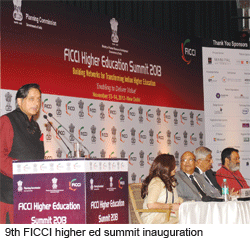A Report Prepared by EY India — a subsidiary of the former Ernst & Young, UK, the world’s third largest professional services (auditing, consultancy, tax advisory) firm (revenue: $25.3 billion or Rs.154,330 crore) — for the 9th FICCI Higher Education Summit 2013 convened in Delhi on November 12-14, predicts that India’s higher education system will emerge as a role model for high-quality affordable education systems in 2030, and will become a global magnet for aspiring learners.
The report titled, FICCI-EY Report on Higher Education in India: Vision 2030 optimistically forecasts that 25 percent of global graduates will be certified by Indian universities when the country’s GER (gross enrollment ratio) will rise to 50 percent. With more than 70 million students enrolled in its higher education system, India could become the largest provider of global talent post 2030. The rosy report also foresees 20 Indian universities ranked among the Top 200 and India among the Top five countries in the world in terms of research output, with an annual R&D spend of US$140 billion (Rs.854,000 crore). This is vision 2030, aka potential, of Indian higher education.

.gif)
.gif) “While we have tremendously enhanced capacity, we lag in quality, given inadequate autonomy to our universities. Centralised control and a standardised approach remains at the heart of regulations. We are in the 21st century with a mid-20th century regulatory architecture. During this time we have seen countries like China, Korea and Singapore, transform from developing to advanced economies in a decade due to strategic planning and a larger vision that correlated economic development to transformation in the education sector, in particular higher education and research, to become globally competitive,” state the authors of the FICCI-EY Vision 2030 Report.
“While we have tremendously enhanced capacity, we lag in quality, given inadequate autonomy to our universities. Centralised control and a standardised approach remains at the heart of regulations. We are in the 21st century with a mid-20th century regulatory architecture. During this time we have seen countries like China, Korea and Singapore, transform from developing to advanced economies in a decade due to strategic planning and a larger vision that correlated economic development to transformation in the education sector, in particular higher education and research, to become globally competitive,” state the authors of the FICCI-EY Vision 2030 Report.
According to Amitabh Jhingan, partner and national leader of the education practice of EY India, “to realise the rosy future outlined in the report requires transformative and innovative approach across all the levers of higher education: from curricula and pedagogy to the use of technology to partnerships, governance and funding”. “Making rapid progress over the next two decades would require a committed and concerted effort from all stake-holders involved i.e. academia, ind-ustry, and government,” he said, speaking at the summit.
Although the language of the report is studiously uncritical of government, the sub-text is less than appreciative of successive governments in New Delhi and the states whose continuous ham-fisted interference has dumbed down the country’s promising higher education system to the extent that certificates of an overwhelming majority of India’s 33,000 colleges and 659 universities are untrustworthy and almost worthless. Therefore unsurprisingly, the vision document is a thinly disguised polemic advocating greater freedom and incen-tives for private participation in higher education.
“We urge the government to treat the public and private higher education institutions and universities on a par and provide equal opportunity for funding for faculty development, student scholarships and research grants based on merit. Needless to add that with a share of 64 percent of the total number of institutions and 59 percent of enrollment in the country, the private sector is indeed a critical stakeholder and has been addressing the country’s needs. Entry barriers for setting up higher education institutions and universities should be removed. Trusts, societies and s.25 (of the Companies Act) companies should be facilitated to co-exist with transparent governance frameworks that encourage self-regulation. This will be a positive step forward to attract credible private sector to invest in the higher education space,” said FICCI president Naina Lal Kidwai forthrightly.
Structurally, the FICCI-EY Vision 2030 report recommends division of India’s higher education system into three tiers/segments — a first tier of centres of excellence focused on high quality research and creation of new know-ledge; a second tier of professional education institutions “producing highly employable graduates”, and a third tier of broad-based, highly-accessible universities “designed to expand the reach of higher education to all eligible and deserving students in the country”.
According to EY’s Jhingan, the principal author of the report, govern-ment outlays for higher education have increased significantly in the past few years with plan expenditure on higher education increasing in 2012-13 by 37 percent over the previous year to Rs.26,700 crore. “If the proposed outlay for higher education — RUSA — of Rs.98,000 crore in the 12th and 13th Plan is spent carefully within the framework of the three tiered structure proposed by the EY-FICCI Vision document, the shining goals envisioned can become a reality,” Jhingan told EducationWorld.
That’s a stiff precondition.
Autar Nehru (Delhi)